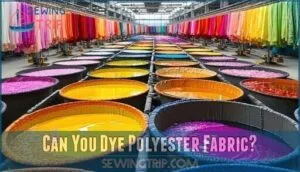This site is supported by our readers. We may earn a commission, at no cost to you, if you purchase through links.

Polyester’s synthetic structure requires disperse dyes, which use heat and chemical bonding to penetrate the plastic-like fibers.
You’ll need temperatures around 200°F and specialized equipment to achieve lasting results.
While it’s more challenging than dyeing cotton, polyester can definitely take color when you use the right approach.
The process involves specific timing, temperature control, and proper preparation to guarantee the dye molecules actually stick to those stubborn synthetic strands.
Table Of Contents
- Key Takeaways
- What is Polyester?
- Can You Dye Polyester Fabric?
- Required Equipment for Dyeing Polyester
- How to Dye Polyester Step-by-Step
- Tips for Dyeing Polyester
- Things to Consider When Dyeing Polyester
- Cleaning Up After Dyeing Polyester
- Alternatives to Dyeing Polyester
- Frequently Asked Questions (FAQs)
- Conclusion
Key Takeaways
- You can’t use regular fabric dyes on polyester – they’re designed for natural fibers and won’t penetrate synthetic materials, leaving you with patchy, temporary results that wash out quickly.
- You’ll need specialized disperse dyes like Rit DyeMore that work specifically with polyester’s plastic-like structure, requiring temperatures around 200°F to open the fibers and allow permanent color bonding.
- Home dyeing is possible but requires dedicated equipment including a large stainless steel pot, heat-resistant tools, and consistent high-heat processing – never use this equipment for food again.
- Success depends on proper technique: maintain boiling temperatures throughout the 30-60 minute process, stir continuously for even coverage, and test on fabric scraps first to avoid costly mistakes.
What is Polyester?
Ever wondered how synthetic materials like polyester get their vibrant colors?
Polyester fiber originates from petrochemical compounds that create a unique challenge for dyeing.
Unlike natural fibers, this synthetic material’s hydrophobic structure repels water-based dyes, making traditional coloring methods ineffective.
Understanding fabric composition becomes essential when working with polyester blends.
The polymer chains in polyester create a non-porous surface that standard dyes can’t penetrate.
This petrochemical origin gives polyester its durability and wrinkle resistance, but also makes it stubborn when you’re trying to change its color.
The polyester dyeing process requires specialized disperse dyes that work at high temperatures to open up the fiber’s crystalline structure.
This textile science breakthrough allows vibrant, permanent colors to bond with polyester fabric dye applications.
Whether you’re working with pure polyester or polyester blend fabrics, understanding these synthetic materials’ unique properties is your first step toward successful dyeing results.
Can You Dye Polyester Fabric?
You can dye polyester fabric, but it requires specialized disperse dyes and heat treatment rather than standard fabric dyes.
Regular all-purpose dyes won’t penetrate polyester’s synthetic fibers, so you’ll need products specifically formulated for synthetic materials to achieve vibrant, lasting color.
Best Dyes for Polyester
When choosing the right polyester fabric dye, disperse dyes like Rit DyeMore deliver superior results compared to traditional fabric dyes.
These synthetic colors penetrate polyester’s hydrophobic surface through heat setting at boiling temperatures. Dye fixatives enhance colorfast methods, ensuring vibrant, permanent results.
The polyester dyeing process requires specialized polyester dye methods that work with synthetic fibers’ unique molecular structure for maximum color retention. Understanding disperse dye properties is essential for achieving the desired color outcome, using colorfast methods.
Dyeing Polyester in a Washing Machine
Yes, you can dye polyester in your washing machine, though results are limited.
Machine dyeing requires temperatures around 100°C for proper color absorption, but standard hot water cycles only reach 60°C.
This means colors will be muted and may wash out quickly.
For best results with washing machine dyeing, use synthetic-specific dyes like iDye Poly with the hottest water setting and longest cycle available.
Pre-wash fabric first and expect faint tints rather than vibrant, permanent colors.
To achieve better results, consider using disperse dye methods that are specifically designed for polyester fabric.
Required Equipment for Dyeing Polyester
You’ll need specific equipment to successfully dye polyester at home since the synthetic fibers require high-heat processing.
The essential tools include a dedicated heat source, proper cookware, and handling utensils designed for fabric dyeing operations, which are crucial for high-heat processing.
Heat Source
You need substantial heat for dyeing polyester since disperse dyes require temperatures above 200°F to properly penetrate synthetic fibers.
A stovetop works best for maintaining consistent boiling water temperatures throughout the dyeing process.
Microwave heating and steam power can supplement your heat source, but thermal energy from direct burner flames provides the most reliable heatset results when working with disperse dyes on polyester fabric.
For ideal results, consider using a stovetop heater to achieve the required temperatures.
Dye Pot
Once you’ve got your heat source ready, you’ll need the right dye pot for successful polyester dyeing. A large stainless steel stockpot works best because it can handle the high dye temperature required for synthetic fibers while providing enough space for your fabric to move freely.
Your pot choice directly affects color mixing results and overall dyeing success. Stainless steel won’t react with dye materials like other metals might, guaranteeing consistent heat settings throughout the process. Remember, this pot becomes your dedicated dyeing vessel—never use it for food again.
Dye Materials: Stainless steel construction prevents chemical reactions
Pot Sizes: Large enough for fabric to float and move freely
Dye Temperature: Must withstand boiling temperatures for disperse dyes
Color Mixing: Non-reactive surface ensures accurate color results
Heat Settings: Even heat distribution prevents hot spots and uneven dyeing
When selecting a dye pot, consider investing in a high-quality stainless steel product to guarantee superior dyeing results.
Utensils
Beyond your dyeing pot, you’ll need proper utensils to handle hot fabric safely.
Grab heat-resistant tongs for lifting wet polyester without burns, plus a dedicated stainless spoon for stirring. Add measuring cups for precise dye ratios and consider a loaf pan for testing swatches.
Reserve this dyeing equipment exclusively for fabric projects—never mix with kitchen tools.
Understanding the right dyeing techniques is essential for a successful polyester dyeing project, using the right techniques.
How to Dye Polyester Step-by-Step
With your equipment ready, you can now transform your polyester fabric through proper dye preparation and heat settings.
Start by filling your dedicated dye pot with enough water to allow the fabric to move freely, then bring it to a rolling boil. Add your disperse dye according to package directions—typically one bottle of Rit DyeMore per pound of fabric for vibrant results.
Here’s your step-by-step process for dyeing polyester fabric:
- Maintain temperature: Keep water at 200°F or higher throughout the entire dyeing process
- Stir continuously: Use tongs to move fabric every few minutes, ensuring even color distribution
- Test timing: Start fabric testing at 30 minutes, extending to 60 minutes for deeper saturation
- Rinse properly: Use cool water until runoff is completely clear, then wash separately
Once you’ve achieved your desired color through proper dye fixation, your polyester clothes will maintain their new hue through countless wash cycles. This method beats any shortcut—patience yields professional results.
Tips for Dyeing Polyester
Successful polyester dyeing requires careful attention to temperature control and timing throughout the process.
You’ll achieve the best results by testing your dye mixture on a fabric swatch first and following manufacturer instructions precisely to avoid common mistakes that lead to uneven coloring, which is crucial for even coloring.
Testing First
Swatch testing reveals how your polyester fabric responds to dye before committing to the full project.
Cut a small fabric sample and apply your chosen dye for polyester using identical conditions you’ll use later.
This color sampling prevents costly mistakes when dyeing polyester fabric.
Understanding dye migration risks is essential for achieving the desired results.
- Test on fabric scraps or inside seams where mistakes won’t show
- Use white cloth underneath to see true color migration during fabric inspection, which helps in identifying dye migration and ensuring the best color sampling.
Following Directions
When dyeing polyester fabric, precision matters more than speed.
Reading labels guarantees you’re using the right dye preparation methods and safety precautions for your specific fabric blend.
Following manufacturer instructions prevents common mistakes like overheating or incorrect ratios that ruin results.
Does dye work on polyester? Absolutely, but success depends on proper technique and understanding color theory principles.
Things to Consider When Dyeing Polyester
Before you start dyeing your polyester fabric, you’ll need to think about a few important factors that can affect your results.
The color of your original fabric and how you plan to mix dyes will determine whether you get the vibrant new look you’re hoping for, considering the complete concepts of fabric and dye interaction.
Previously Dyed Fabric
When working with previously dyed polyester fabric, you’re basically playing a game of chemical roulette.
The original disperse dyes create a foundation that affects how new colors absorb, often resulting in unexpected shade variation and dye overlap that can turn your project into a muddy mess.
- Color fading rarely occurs – polyester’s heat-set dyes resist tint removal, making lighter colors nearly impossible to achieve over dark bases
- Fabric bleeding becomes unpredictable – existing patterns and logos will mix with new dyes, creating uncontrolled color combinations
- Overdyeing remains your best bet – darker shades can mask previous colors, though polyester dyeing tips suggest testing small sections first to predict final results
Mixing Dye Colors
Color theory becomes your roadmap when mixing dye colors for polyester fabric.
Understanding hue combinations lets you create custom shades beyond basic options.
Primary colors blend into vibrant secondaries—blue plus yellow yields green, while red and blue produce purple.
Disperse dyes for polyester follow these same principles, though synthetic fibers require precise ratios.
Test small batches first to perfect your tint effects before dyeing polyester clothes completely.
To achieve superior results, consider the importance of proper dye preparation techniques when working with synthetic fibers, and remember that proper preparation is key.
Cleaning Up After Dyeing Polyester
Proper cleanup protocols become essential once your dyeing polyester project wraps up. Immediate attention to equipment sanitizing prevents permanent staining and helps your tools remain functional for future projects.
Key cleanup priorities for fabric dyeing success:
- Dye removal from all surfaces – Scrub your sink, dye pot, and tongs with soft cleanser to eliminate fabric residue and prevent color bleeding onto future items
- Stain prevention measures – Clean equipment while dye particles remain wet, as dried residue becomes substantially harder to remove
- Equipment maintenance – Dry all metal tools immediately after cleaning to prevent rust formation that could contaminate future dyeing sessions
Thorough fabric rinsing of your workspace prevents cross-contamination with food preparation areas. Store your dyeing polyester cleanup products in a dedicated location, separate from kitchen supplies. With consistent cleaning habits, your equipment stays ready for the next creative endeavor without lingering chemical odors or stubborn stains. Understanding polyester dye basics is vital for a successful dyeing project and subsequent cleanup.
Alternatives to Dyeing Polyester
Several fabric dyeing alternatives exist when traditional dyeing polyester fabric proves challenging. These methods offer creative control without requiring specialized synthetic dye options or polyester dyeing kits.
Fabric Painting transforms polyester using acrylic paints mixed with fabric medium. This technique creates precise designs and patterns while maintaining flexibility after heat-setting.
Sublimation printing uses heat to transfer vibrant designs directly into polyester fibers. Professional results rival commercial screen printing quality, making it ideal for detailed graphics.
Tie Dye effects emerge using bleach instead of traditional dye for polyester. Scrunch fabric, apply diluted bleach solution, then neutralize thoroughly for unique patterns.
Embroidery adds permanent color through decorative stitching. Combine with other techniques for mixed-media results that won’t fade or wash out like conventional dyes might on synthetic fabrics.
Understanding polyester dye basics is essential for achieving the best results with these alternative methods.
These alternatives bypass polyester’s dye-resistant properties while delivering professional-looking results.
Frequently Asked Questions (FAQs)
Does disperse dye work on polyester?
Yes, disperse dyes work excellently on polyester. You’ll need heat to activate these specialized dyes, which penetrate polyester’s synthetic fibers effectively, creating permanent, vibrant colors that won’t fade or bleed.
Can you use natural dye on polyester?
Unfortunately, you can’t swim upstream against polyester’s synthetic nature with natural dyes. Natural dyes work on cotton and wool but won’t penetrate polyester’s hydrophobic fibers, requiring specialized disperse dyes instead.
What happens if you use regular dye on polyester?
Regular dye won’t stick to polyester fibers because they’re hydrophobic and non-porous. You’ll end up with patchy, washed-out colors that fade quickly since water-based dyes can’t penetrate synthetic fibers effectively.
How do you dye polyester & other synthetic fabrics?
Want to transform your synthetic fabric’s color?
Use disperse dyes like Rit DyeMore with boiling water and dish soap.
Submerge fabric for thirty minutes, stirring continuously.
These specialized dyes penetrate polyester’s non-porous fibers effectively.
Can You dye polyester fabric in a non-industrial setting?
You can dye polyester at home using disperse dyes like Rit DyeMore, which require high heat and specialized techniques for proper color penetration and permanence.
Can you use dye remover on polyester?
About 95% of color removers fail on synthetic fibers due to their chemical structure.
You can’t effectively use dye remover on polyester because its crystalline polymer chains resist penetration from bleaching agents, making overdyeing your only viable option.
What fabric dye is best for polyester?
Disperse dyes like Rit DyeMore work best for polyester since they’re specifically formulated for synthetic fibers. You’ll need high heat to open polyester’s crystalline structure and allow proper dye penetration.
What fabrics cannot be dyed?
Ever wondered which fabrics laugh in the face of dye? Synthetic powerhouses like acrylic, nylon blends, spandex, and polyurethane resist color absorption due to their non-porous structure and chemical composition.
How to prep polyester for dyeing?
First, check your polyester’s composition on the care label—you’ll need disperse dye for fabrics containing over 35% polyester.
Wash the item thoroughly to remove oils and stains, then weigh it to determine dye amounts needed.
How long does it take to dye polyester?
Dyeing polyester takes 30-45 minutes total: 10 minutes stirring continuously in boiling disperse dye, then 30 minutes soaking.
You’ll need high heat throughout the process since polyester’s stubborn fibers resist color absorption without sustained temperature.
Conclusion
While cotton accepts dye like a thirsty sponge, polyester requires a completely different approach.
Successfully dyeing synthetic fabrics demands disperse dyes, precise temperature control at 200°F, and specialized equipment.
The question "does fabric dye work on polyester" has a definitive answer: yes, when you follow proper chemical bonding techniques.
Regular fabric dyes simply won’t penetrate polyester’s plastic-like structure, but disperse dyes create lasting color through heat activation and molecular adhesion to synthetic fibers.
- https://www.dharmatrading.com/dyes/industrial-polyester-dyes.html
- https://www.ritdye.com/type/dyemore-for-synthetics/
- https://textile-yarn.com/blog/how-to-dye-polyester-yarn/
- https://www.reddit.com/r/dyeing/comments/yd6bqd/question_about_dyeing_polyester/
- https://www.longancraft.com/blogs/sewing-projects/how-to-dye-polyester-fabric











